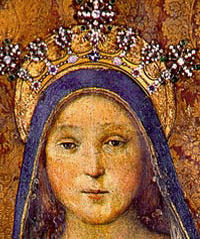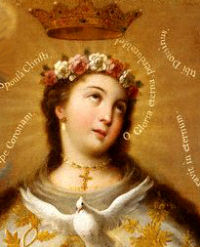Ordinary Time: August 22nd
Feast of the Queenship of the Blessed Virgin Mary
Old Calendar: Immaculate Heart of the Blessed Virgin Mary; Sts. Timothy, Hippolytus & Symphorian, martyrs
The faithful, under the guidance of an unerring Catholic instinct, have ever recognized the queenly dignity of the Mother of "The King of kings and Lord of lords": the Fathers, the Doctors of the Church, Popes, down through the centuries, have given authoritative expression to this truth and the crowning testimony to this common belief is to be found clearly expressed in the wonders of art and in the profound teaching of the liturgy. In their turn theologians have shown the fitting nature of this title of Queen as applied to the Mother of God, since she was so closely associated with the redemptive work of her Son and is the Mediatrix of all graces. Pius XII, by his encyclical letter of October 11, 1954, granted the unanimous desire of the faithful and their pastors and instituted the feast of the Queenship of Mary, giving sanction thus to a devotion that was already paid by the faithful throughout the world to the sovereign Mother of heaven and earth.
According to the 1962 Missal of St. John XXIII the Extraordinary Form of the Roman Rite, today is the feast of the Immaculate Heart of the Blessed Virgin Mary which is celebrated in the Ordinary Rite on the Saturday following the Second Sunday after Pentecost.
It is also the commemoration of Sts. Timothy, Hippolytus and Symphorian. St. Timothy is a Roman martyr put to death in 303 or 306 during the last persecution. His body lies at St. Paul's-Outside-the-Walls, near that of the great Apostle. The history of St. Hippolytus, martyred at Ostia, near Rome, remains extremely obscure; it is probably in error that he is called bishop of Porto. St. Symphorian was a martyr of Autun, put to death while still a young man in the second or third century. He is one of the great saints of Gaul and several churches were built in his honor. His Acts appear to be genuine.
Queenship of Mary
 With the certainty of faith we know that Jesus Christ is king in the full, literal, and absolute sense of the word; for He is true God and man. This does not, however, prevent Mary from sharing His royal prerogatives, though in a limited and analogous manner; for she was the Mother of Christ, and Christ is God; and she shared in the work of the divine Redeemer, in His struggles against enemies and in the triumph He won over them all. From this union with Christ the King she assuredly obtains so eminent a status that she stands high above all created things; and upon this same union with Christ is based that royal privilege enabling her to distribute the treasures of the kingdom of the divine Redeemer. And lastly, this same union with Christ is the fountain of the inexhaustible efficacy of her motherly intercession in the presence of the Son and of the Father.
With the certainty of faith we know that Jesus Christ is king in the full, literal, and absolute sense of the word; for He is true God and man. This does not, however, prevent Mary from sharing His royal prerogatives, though in a limited and analogous manner; for she was the Mother of Christ, and Christ is God; and she shared in the work of the divine Redeemer, in His struggles against enemies and in the triumph He won over them all. From this union with Christ the King she assuredly obtains so eminent a status that she stands high above all created things; and upon this same union with Christ is based that royal privilege enabling her to distribute the treasures of the kingdom of the divine Redeemer. And lastly, this same union with Christ is the fountain of the inexhaustible efficacy of her motherly intercession in the presence of the Son and of the Father.
 With the certainty of faith we know that Jesus Christ is king in the full, literal, and absolute sense of the word; for He is true God and man. This does not, however, prevent Mary from sharing His royal prerogatives, though in a limited and analogous manner; for she was the Mother of Christ, and Christ is God; and she shared in the work of the divine Redeemer, in His struggles against enemies and in the triumph He won over them all. From this union with Christ the King she assuredly obtains so eminent a status that she stands high above all created things; and upon this same union with Christ is based that royal privilege enabling her to distribute the treasures of the kingdom of the divine Redeemer. And lastly, this same union with Christ is the fountain of the inexhaustible efficacy of her motherly intercession in the presence of the Son and of the Father.
With the certainty of faith we know that Jesus Christ is king in the full, literal, and absolute sense of the word; for He is true God and man. This does not, however, prevent Mary from sharing His royal prerogatives, though in a limited and analogous manner; for she was the Mother of Christ, and Christ is God; and she shared in the work of the divine Redeemer, in His struggles against enemies and in the triumph He won over them all. From this union with Christ the King she assuredly obtains so eminent a status that she stands high above all created things; and upon this same union with Christ is based that royal privilege enabling her to distribute the treasures of the kingdom of the divine Redeemer. And lastly, this same union with Christ is the fountain of the inexhaustible efficacy of her motherly intercession in the presence of the Son and of the Father.
Without doubt, then, does our holy Virgin possess a dignity that far transcends all other creatures. In the eyes of her Son she takes precedence over everyone else. In order to help us understand the preeminence that the Mother of God enjoys over all creation, it would help to remember that from the first moment of her conception the holy Virgin was filled with such a plenitude of grace as to surpass the graces enhancing all the saints. Recall what our predecessor Pius IX, of blessed memory, wrote in his Bull Ineflabilis Deus: "More than all the angels and all the saints has God ineffable freely endowed Mary with the fullness of the heavenly gifts that abound in the divine treasury; and she, preserving herself ever immaculately clean from the slightest taint of sin, attained a fullness of innocence and holiness so great as to be unthinkable apart from God Himself, a fullness that no one other than God will ever possess."
Spurred on by piety and faith, may we glory in being subject to the rule of the Virgin Mother of God; she bears the royal sceptre in her hand, while her heart is ever aflame with motherlove.
Excerpted from Ad Caeli Reginam, Pius XII
http://www.ibreviary.com/m/breviario.php?s=ufficio_delle_letture
SECOND READING
From a homily by Saint Amadeus of Lausanne, bishop
(Hom. 7: SC 72, 188, 190, 192, 200)
Queen of the world and of peace
Observe how fitting it was that even before her assumption the name of Mary shone forth wondrously throughout the world. Her fame spread everywhere even before she was raised above the heavens in her magnificence. Because of the honor due her Son, it was indeed fitting for the Virgin Mother to have first ruled upon earth and then be raised up to heaven in glory. It was fitting that her fame be spread in this world below, so that she might enter the heights of heaven on overwhelming blessedness. Just as she was borne from virtue to virtue by the Spirit of the Lord, she was transported from earthly renown to heavenly brightness.











